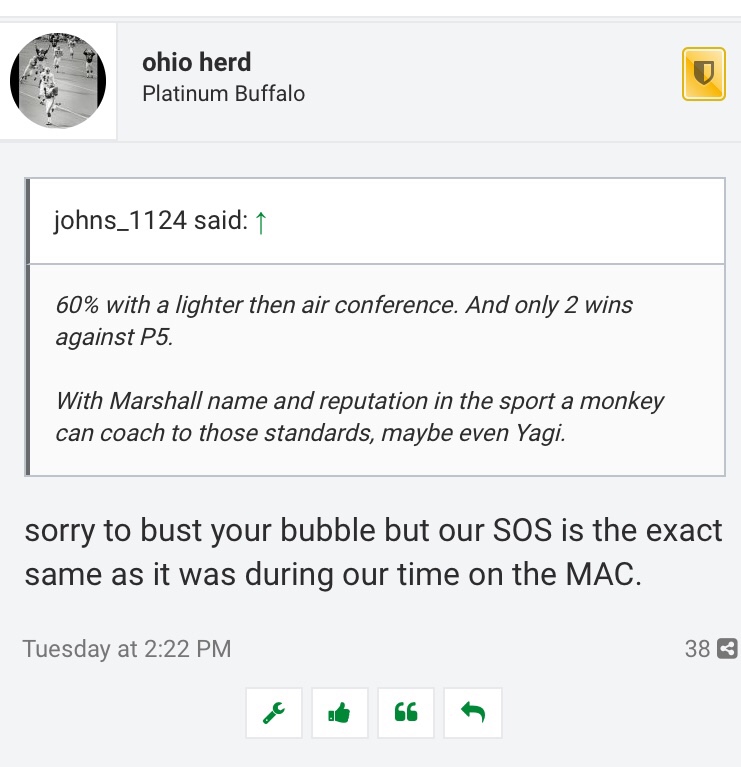Since 1992, 27 teams have joined FBS -
Christ, that's quite a change from your last statement in which you said after the successful run of Marshall in the late nineties. Due to your statement, I looked at the teams that joined the FBS starting from 2000 on. Now, you want to look at the teams that started FBS since 1992? That makes absolutely no sense in the context of this discussion considering Marshall wasn't FBS until 1997. We are comparing SOS numbers from Marshall's MAC years compared to Doc's tenure. What do teams having joined FBS BEFORE Marshall did have anything to do with the huge disparity between Marshall's SOS from the MAC years until now? I'll answer for you: absolutely nothing.
The conference Marshall currently plays in features only three schools who were members of FBS prior to this expansion. The majority of it's member institutions didn't join FBS until the current century, and two of those schools didn't even have football the day Mark Snyder was fired.
.
Yep. You're now supporting our argument. The majority of C-USA schools, according to you, started FBS after Marshall, giving Marshall even more of an advantage.
According to statistics on college athletic expenditures compiled and published by USA Today, Marshall ranks 104th in all of college sports, behind many schools that don't even play football.
.
Great. An overall college's athletics budget is not a strong indicator of the amount they invest in football. If School A spends $30 million to fund 22 sports while School B spends $28 million to fund 10 sports, you can be pretty assured that School B spends more on football than School A, yet your comment doesn't reflect that since School B has a lower overall athletics budget.
Want to look at what matters? Look at only football spending, not an overall athletic department's spending. Even at that, there is far more that goes into success in a college football program than how much a school shows on its budget . . . not to mention SOS rankings.
Of the 27 teams who've joined FBS since 1992, 18 of them currently have higher athletic budgets than Marshall.
Again, you're looking at overall athletic budgets. That doesn't provide much help to your argument unless you are looking at specifically football budgets, which as I also said, is only part of the equation of success in football.
But let's give you the entire benefit of the doubt. Put all 18 of those schools you claim that have higher athletic budgets (which isn't the same as football) ahead of MU in SOS during the MAC years. Of course, since some of those started FBS as early as 1992, they'd be counted twice as being ahead of Marshall in SOS, but again, I'm trying to give your argument every benefit of the doubt possible (even if it is illogical). Assume, illogically, that all 18 of those schools with higher budgets means they have a harder SOS than Marshall. Even after adding those 18 to Marshall's SOS rankings from the MAC years, they still aren't as bad at Marshall's SOS over the last 6 years.
Counting only the increase in scholarships from moving up from FCS, the teams who have joined FBS since Marshall made the jump account for 400 additional scholarships that didn't exist in FBS in September 1997.
.
Now, you want to start looking at teams since 1997. Earlier, when you needed help with your argument, you wanted to look at teams who jumped from 1992. Ugh, yeah.
More important, what the hell does the increased number of FBS scholarships available have to do with the SOS of Marshall changing? Nothing? I agree.
Marshall joined the MAC when it moved up, then advanced to C-USA, which then collapsed during realignment (brought on by large institutions who wanted to reinstate the FBS/FCS divide), leaving it adrift in a Conference of Misfit Toys, in what is ostensibly an FCS conference.
.
Yeah, I agree. Marshall is now playing in a much weaker conference with a bunch of teams that started after Marshall, which has resulted in Marshall having a much easier schedule, yet Marshall's record is far worse than it was when playing in the MAC (against a harder schedule versus far more established programs).
Remember, this discussion was about somebody claiming that Marshall's SOS is "exactly the same" as it was in the MAC days. That's incredible inaccurate.
Last year, participation in football in American high schools dropped to its lowest point in ten years. 40,000 fewer students played in 2017 than in 2015.
.
And again, what does this have to do with Marshall having faced a far harder schedule during the MAC days compared to Doc's last six years? A lower pool of high school players would impact every team, including Marshall's competitors.
I'm really hoping you were just trying to keep the balloon afloat with this post, as it had absolutely nothing to do with the discussion or even with your previously failed post.
